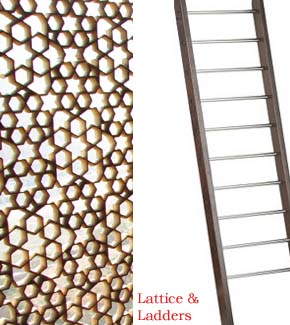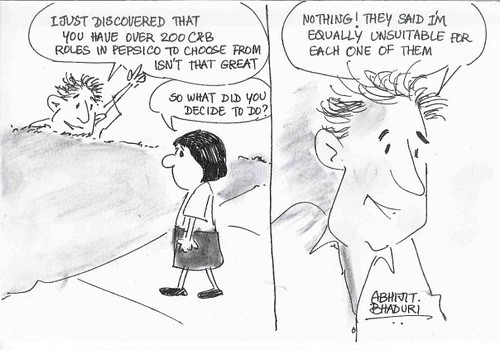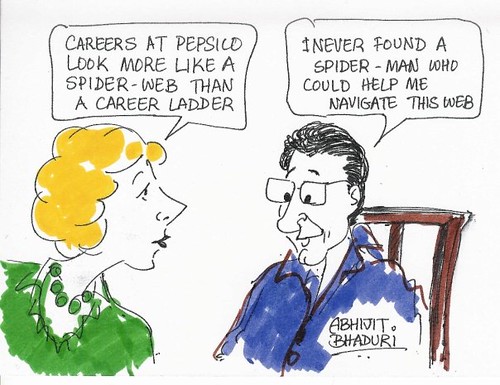 Mass Customization may seem like an oxymoron. When you think of something as individualistic as career choices, it begs the question how far such a thing is possible. Organizations have long defined successful careers to represent a ladder. Ladders were for lads and too bad if the ladies chose to opt out of it. With the changing demographics, all that is changing at a reasonable pace. The Wall Street Journal bestseller Mass Career Customization by Cathleen Benko and Anne Weisberg point out that the demand and supply gap will force corporations to explore new ways of defining careers which will look less and less like the ladder people have used to scale the organizational pyramid. Individuals are using lattices to move to different directions and vary the pace and nature of their assignments while still remaining valuable contributors to the workforce.The corporate ladder gave people an up or out choice everytime life stages placed demands on them. The ladder approach assumes that your needs remain constant over time and that the employee will continue to opt out of the race forever if their family situation placed demands on them. Women have for long had to face a choice of ignoring their bio-clock if they had to keep their career ambitions intact. There are many men who are increasing unwilling to trade-off life stage demands and opt out of thriving careers. It is not for nothing that it is called the AND Generation of employees. They want to have flourishing careers and also nurture other roles as they happen. Whether it is to take care of aging relatives or to spend time with their children and take up an interesting assignment that is professionally meaningful, they want it all. They want to have their cake AND eat it too. So the bakery has to redefine what a cake looks like. It looks like a lattice.
Mass Customization may seem like an oxymoron. When you think of something as individualistic as career choices, it begs the question how far such a thing is possible. Organizations have long defined successful careers to represent a ladder. Ladders were for lads and too bad if the ladies chose to opt out of it. With the changing demographics, all that is changing at a reasonable pace. The Wall Street Journal bestseller Mass Career Customization by Cathleen Benko and Anne Weisberg point out that the demand and supply gap will force corporations to explore new ways of defining careers which will look less and less like the ladder people have used to scale the organizational pyramid. Individuals are using lattices to move to different directions and vary the pace and nature of their assignments while still remaining valuable contributors to the workforce.The corporate ladder gave people an up or out choice everytime life stages placed demands on them. The ladder approach assumes that your needs remain constant over time and that the employee will continue to opt out of the race forever if their family situation placed demands on them. Women have for long had to face a choice of ignoring their bio-clock if they had to keep their career ambitions intact. There are many men who are increasing unwilling to trade-off life stage demands and opt out of thriving careers. It is not for nothing that it is called the AND Generation of employees. They want to have flourishing careers and also nurture other roles as they happen. Whether it is to take care of aging relatives or to spend time with their children and take up an interesting assignment that is professionally meaningful, they want it all. They want to have their cake AND eat it too. So the bakery has to redefine what a cake looks like. It looks like a lattice. Forward looking companies like PepsiCo have long defined careers to be like a web. They have recognized that it is an essential part of their strategy of retaining talent. It is not about a vertical growth always. It is about collecting a bunch of experiences in line with the way you define your career. I had drawn this cartoon strip for one of the brochures that Pepsi was planning to illustrate the choices that were possible. In Compensation & Benefits (C&B for short) there were almost 200 possible combinations of roles at various levels and business and locations. So what was driving that approach to careers. More women in the workforce, changing expectations of the male employees, changing nature of the family and of course the options like remote working that technology has thrown up. You do not need to be in the office to join a meeting. While that may throw open its own set of challenges, there is no doubt that we can offer such options to more and more people at the workplace.Mass Career Customization relies on four factors on a 6 point scale:1. PACE: Options relating to the rate of career progression that range from Decelerated to Accelerated2.WORKLOAD: Choices related to quantity of work output from Reduced to Full.3. LOCATION: Options for when and where work gets performed ranging from Restricted to Not restricted4. ROLE: Choices in position and responsibilities from Individual contributor to Leader.This Mass Career Customization or MCC Profile of each employee can be worked at different stages of their career and life stage. Adopting a child may create demands on the person that may mean a relook at Pace, Workload, Location and Role in order to make space for the new realities.Like it or not the demographic changes are going to make all this happen faster than you think. Just look at the comparison of the Population Pyramids of India in 2010 and 2050. Looking at the visual representation of age and sex ratios changing over the next 40 years can help us think through what changes it will bring into the workplace. Add to it many other social factors eg Increasing number of nuclear families where both husband and wife are working could lead us to think of how it will affect choices of such couples when it comes to mobility and career. It is not going to be ladders but lattices that will define the workplace architecture.
Forward looking companies like PepsiCo have long defined careers to be like a web. They have recognized that it is an essential part of their strategy of retaining talent. It is not about a vertical growth always. It is about collecting a bunch of experiences in line with the way you define your career. I had drawn this cartoon strip for one of the brochures that Pepsi was planning to illustrate the choices that were possible. In Compensation & Benefits (C&B for short) there were almost 200 possible combinations of roles at various levels and business and locations. So what was driving that approach to careers. More women in the workforce, changing expectations of the male employees, changing nature of the family and of course the options like remote working that technology has thrown up. You do not need to be in the office to join a meeting. While that may throw open its own set of challenges, there is no doubt that we can offer such options to more and more people at the workplace.Mass Career Customization relies on four factors on a 6 point scale:1. PACE: Options relating to the rate of career progression that range from Decelerated to Accelerated2.WORKLOAD: Choices related to quantity of work output from Reduced to Full.3. LOCATION: Options for when and where work gets performed ranging from Restricted to Not restricted4. ROLE: Choices in position and responsibilities from Individual contributor to Leader.This Mass Career Customization or MCC Profile of each employee can be worked at different stages of their career and life stage. Adopting a child may create demands on the person that may mean a relook at Pace, Workload, Location and Role in order to make space for the new realities.Like it or not the demographic changes are going to make all this happen faster than you think. Just look at the comparison of the Population Pyramids of India in 2010 and 2050. Looking at the visual representation of age and sex ratios changing over the next 40 years can help us think through what changes it will bring into the workplace. Add to it many other social factors eg Increasing number of nuclear families where both husband and wife are working could lead us to think of how it will affect choices of such couples when it comes to mobility and career. It is not going to be ladders but lattices that will define the workplace architecture.
 Read the book to learn about how companies are dealing with the shifts in demographics.Finally a lighthearted look at the notion of the Career like a spider web that I had referred to.
Read the book to learn about how companies are dealing with the shifts in demographics.Finally a lighthearted look at the notion of the Career like a spider web that I had referred to.
—
Written By
Mass Career Customization
Comments
6 responses to “Mass Career Customization”
-
Hey! I love the pictures……..
-
‘Ladder to Lattice’ is somehow like ‘Move around to move up’, isn’t it? Most fwd-looking and especially small, niche, tech co’s have been doing that for quite some time, no? But, at an individual level, drastic career shifts or changes are still seen as a mental embargo of sorts- in indian context…. Have you read Rama Bijapurkar’s ‘We are like that only’? – A nice take on the very very typical Indian market-mindset…May be someone should write a similar one on the ‘typical indian Job-market’ mindset?- may be, you?loved the cartoon :))- considering we badly need an indianized ‘Dilbert’ (like Krish- Indianized superman) to vent out our job-related cumulative frustu’s, wonder if your next ‘serious’ book could be a cartoon plus write-up’s one :)) ?
-
Nowadays organizations have started giving the option of either technical path or management path for their employees. Management path for those who like the ladder and technical path for those who like the lattice. But I think in the Indian context it is difficult to convince employees that technical path is equally. It will take atleast 5 years for the Indian professionals to think the lattice way.
-
This got me thinking of ‘design’ or ‘default’. Lattice seems to provide more options…very often these options get picked up by ‘default’, If one has to succeed one will need to see the ‘lattice’, and prepare oneself to make the ‘leap’ and not the ‘climb’…typically we think ‘climb’ right.?
-
I also think that ‘mass career customization’ is an idea/HR practice that has immense potential. Yes, traditional career paths are only of limited relevance in many of the organizations today. Mass career customization goes much beyond a transition from ‘career ladders’ to ‘career lattices’. Yes, lattices can be an important building block. But mass career customization is also about increasing the number of options (along with defining and delivering the implications of the options) the while being at a particular point in the lattice.I am very keen to know if the organizations implementing mass career customization are able to sustain the effectiveness of implementation over a period of time – especially when the external environment and the organizations undergoes significant changes. The main issue is whether the organization continues to be in a position to keep its part of the bargain (regarding the availability of the choices and its defined reward/advancement implications). The new business context might mean might require a redefinition of the career choices and its implications.Another interesting issue here is whether the organization extends mass career customization to all the employees or only a select few. After all, the organization has to meet its goals. If all the employees make choices independently, the aggregate of the choices might not add up to what the organization wants to accomplish.Thus, it would be very interesting to see how these efforts at mass career customization play out over a period of time, across industry sectors and across different points in the business cycle.
-
Thank you for your sharing, this saved me after three hours of research.


Leave a Reply